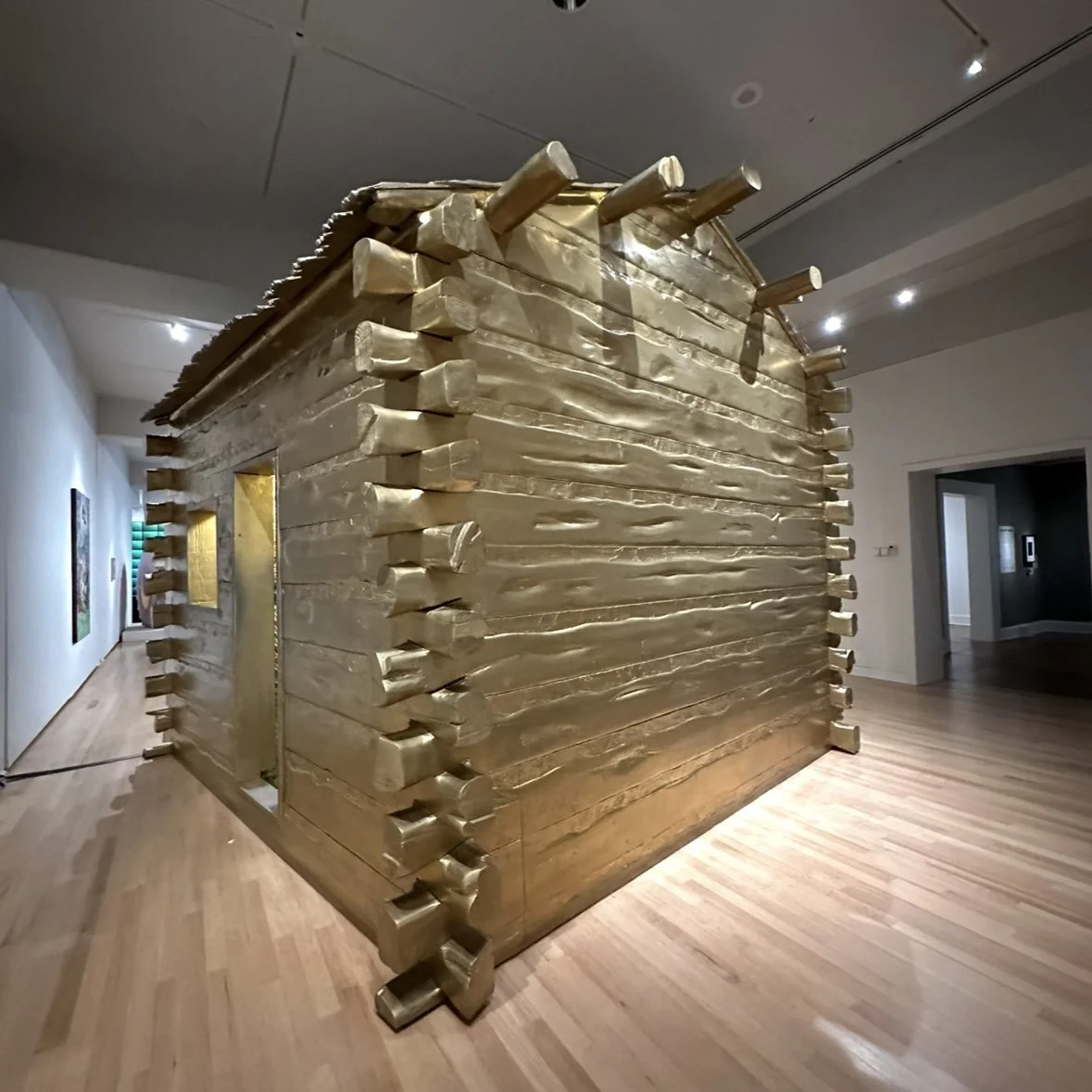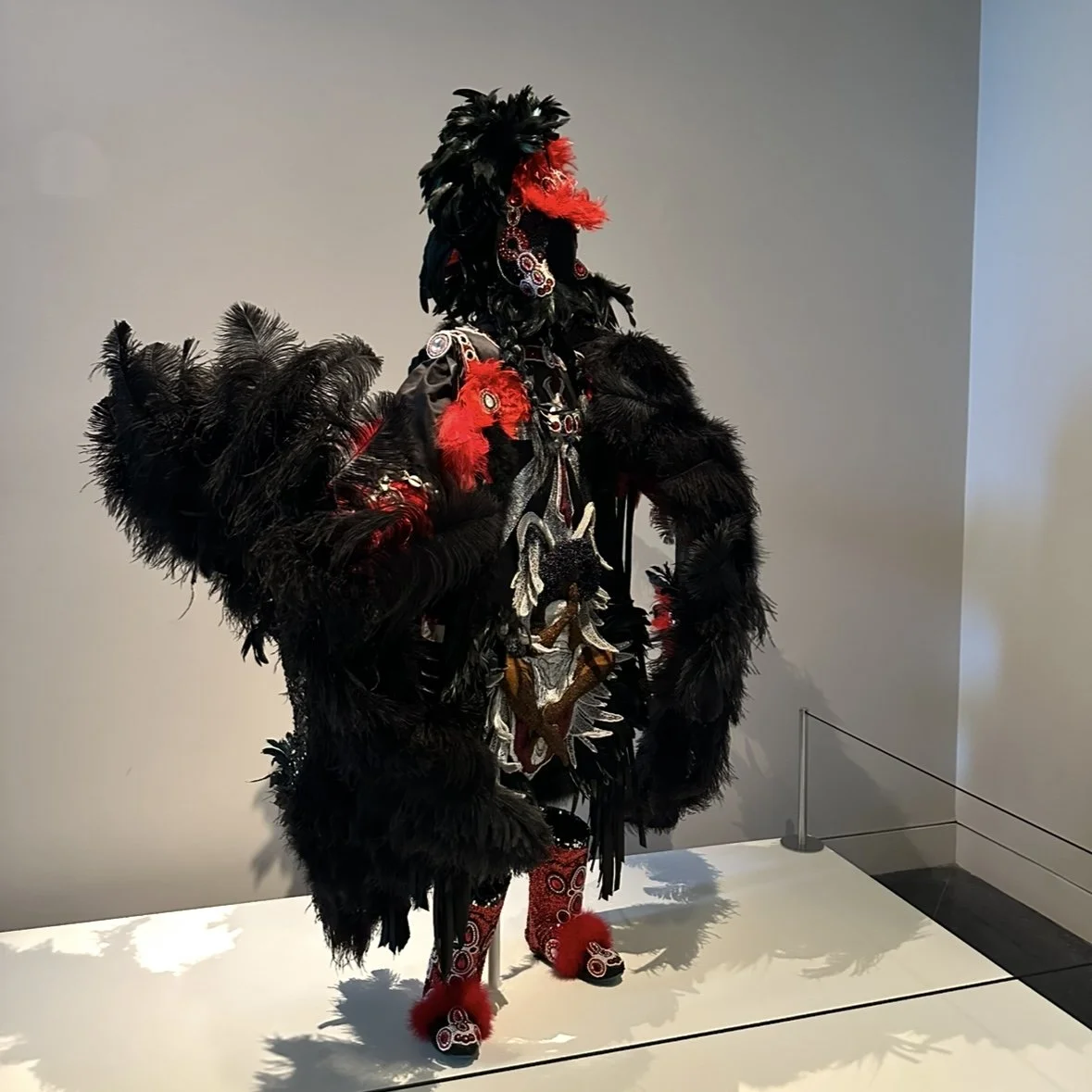“There was the house we lived in and the house we thought we should live in. There was the house we thought we should live in and the house other people thought we lived in. These houses were colliding.””
There’s a house in the New Orleans Museum of Art. An actual house.
When you enter the second floor exhibit filled with modern art pieces, you will see it.
It stands 14 feet wide, 14 feet long, and 13 feet tall – a life-size replica of Abraham Lincoln’s childhood log cabin. Its wooden exterior coated in gold, the house gleams warmly under the cold museum light.
Peeking through the opening of the window or entering through the doorway, you’ll see layers and panels of ordinary objects, all rigidly and compactly welded together in thin, neat lines not unlike the stripes of the American flag. The floor is laid with coils of shackles and chains. The fireplace is veneered with bricks of iPhones and iPads. The wall is divided into angular, geometric chunks filled with repeating objects – soda tabs, pills, keyboard keys, metal springs, seed cotton, candy, lightbulbs, telephone cords, railroad tires, corn – all clustering together like pieces of mosaic. The entirety of the house is painted gold, apart from sections of the wall that are constructed with hunks and wedges of black, lusterless coal.
This is Will Ryman’s 2013 sculpture America, a large-scale installation that critically reflects the industries and economies that have shaped the United States. From the brutal institution of slavery which has laid the foundations of this nation to to the gleaming prestige of today’s tech giants, America captures our nation as a glorious crystallization of generations of blood, sweat, and tears. Overwhelmed by the lustrous glow of the house, I found it easy to overlook the individual components composing it. It’s hard to focus on that one seemingly negligible, yet absolutely crucial, question: what has been the true cost of building such a beautiful structure, and by extension, our nation?
To me, this sculpture was a striking synthesis of everything we explored over the past week as we confronted New Orleans’ history of trauma and horror. Faced with the grotesque realities of slavery portrayed in 12 Years a Slave and in our visit to the Whitney Plantation, my prior image of New Orleans as a leisurely city of French delicacies and beautiful art crumbled. Accompanied by Sarah Broom’s words in The Yellow House, which echoed through our travels, I felt my own ignorance laid bare and called out by the very voices I had overlooked: “The mythology of New Orleans—that it is always the place for a good time; that its citizens are the happiest people alive, willing to smile, dance, cook, and entertain for you; that it is a progressive city open to whimsy and change—can sometimes suffocate the people who live and suffer under the place’s burden, burying them within layers and layers of signifiers, making it impossible to truly get at what is dysfunctional about the city.”
In many ways, we live in America, this gilded house of gold that is both New Orleans and the nation itself. As a young girl growing up in China, my parents and I looked across the Pacific toward this country, imagining it as a land of opportunity and dreams. From afar, we saw a place wrapped in mythologies of glamour, romance, and dazzling opulence: a house that, from the outside, seemed to shine with promise, drawing in those who longed to know what it might be like to live within its walls.
But America’s interior tells an entirely different story. Only those who built its doors, its frames, its walls and ceilings, can speak to the unpresentable scraps and discarded remnants hidden beneath its glittering surface. Only those who live inside can describe the pungent stench of cheap plastic, the gritty scent of coal embedded in its foundation and its walls. The story they tell is solemn, stripped of illusion. No veneer of gold can change this fact.
The French Quarter is a thorny rose dyed red with blood, flourishing atop the bones of unnamed victims buried deep within its elevated ground. In desperation, we tell ourselves that tormented souls haunt the streets at night – as if mystifying their suffering could soften its brutality, and granting them the power to haunt might offer some form of poetic justice.
These terrors from the past gnaw into our present. Like termite holes digging deep into the wood beams of an old cabin, memories and attitudes linger on in the form of mindless “plantation weddings” and tasteless scarf designs of plantations that line the Mississippi River. Again, I was reminded of what Sarah Broom wrote about New Orleans: “The historicized past is everywhere I walk in my daily rituals—to get to the store or to the gym on Rampart Street or to my car to visit with Carl. Historical markers are everywhere you look—underfoot and on buildings.”
Yet through it all, the story of New Orleans is one of resilience. In a world where all seemed lost, courageous African American communities found hope through various forms of art.
Hope is a set of vodou dolls that carry good luck, health, and happiness for family faraway. Hope is a gospel song echoing the words of Exodus, singing of faith and liberation. Hope is a Mardi Gras Indian costume adorned with colorful beads and lively feathers, a valiant expression of identity and heritage. Hope is the sound of a trumpet in a Second Line parade, where laughter rings out and the community gathers.
On the white walls of the museum, a two-line quote by Kenyan-American artist Wangechi Mutu stood out to me: “An artist is a healer. First, they heal themselves, and then they try, bit by bit, to heal others.” Even in the darkest of times, art offers not only solace but also strength – it is not only a means of expression, but a chance to rewrite narratives and shift perspectives. Just like renovations to an old house can transform it into something new, our understanding of the world, our shared home, can also evolve and change with art pieces like America and the Yellow House
I really have faith that art and courage has the power to make the world a better place!


